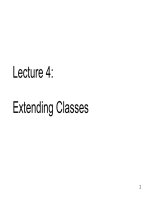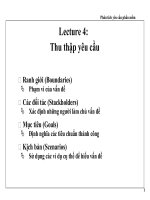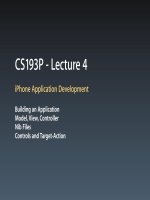Lecture 4 DictionaryMethods
Bạn đang xem bản rút gọn của tài liệu. Xem và tải ngay bản đầy đủ của tài liệu tại đây (272.02 KB, 44 trang )
1
Data Compression
Lecture 4
Dictionary Methods
Alexander Kolesnikov
2
Dictionary based methods
•
Statistical compression methods use a statistical model
of the data, and the quality of compression they achieve
depends on how good that model is.
•
Dictionary-based method do not use statistical model
of data. Instead they select strings of symbols and
encode each string as a
token
using a dictionary.
•
The dictionary holds strings of symbols and it may be
static or dynamic (adaptive).
•
To encode text one can use a (static) dictionary of the
English (Finnish, etc.) language.
•
What about images?
3
Dictionary-based methods: Main idea
•
Encoder: As the input is processed, develop a dictionary
and transmit the index of strings found in the dictionary
•
Decoder: As the code is processed, reconstruct the
dictionary to invert the process of encoding
4
Dictionary-based methods: History
•
1977: LZ77 [Lempel, Ziv]
* 1982: LZSS [Storer, Szymanski]
* LZR, LZH, etc.
* Gzip, PKZip, LHarc, Zoo for files
* PNG image format
•
1978: LZ78 [Lempel, Ziv]
* 1984: LZW [Welch] algorithm
* GIF image format
* V.42bis data compression standard for modems
5
LZ77 – Giới thiệu
LZ77 được Jacov Ziv và Abraham Lempel đưa ra
vào năm 1977. LZ77 là một thuật toán nén dựa
trên từ điển.
Thuật toán:
Sử dụng một con trỏ dịch chuyển trên xâu kí tự
đầu vào. Ban đầu con trỏ trỏ vào vị trí 1.
Qui ước: từ con trỏ trở về trước được gọi là quá
khứ, còn từ con trỏ trở về sau được gọi là tương
lai. Tránh trường hợp quá khứ dài vô tận người ta
đặt kích thước của cửa sổ quá khứ là w bằng số kí
tự dài nhất có thể trùng khớp với các kí tự trong
tương lai.
6
LZ77 – thuật toán nén
Pos - là vị trí đang xét. Ban đầu Pos bằng 1.
Match – xâu dài nhất được tìm thấy trong
cửa sổ.
Char – kí tự vừa đọc.
Output - thể hiện trong dạng (i, j) C:
(i,j) thể hiện vị trí so khớp và độ dài xâu tương
ứng
C kí tự rõ trong buffer.
7
LZ77: Example 1
sir_sid_eastman_easily_teases_sea_sick_seals ...
search buffer
look-ahead buffer
sir_sid_eastman_ ⇒ (0,0,’s’)
sir_sid_eastman_e ⇒ (0,0,’i’)
sir_sid_eastman_ea ⇒ (0,0,’r’)
sir_sid_eastman_eas ⇒ (0,0,’_’)
sir_sid_eastman_easi ⇒ (4,2,’d’)
8
LZ77: Decoding
Codes: (0, 0,’s’) (0,0,’i’) (0,0,’r’) (0,0,’_’) (4,2,’d’)
Message:
1. (0, 0,’s’): s
2. (0,0,’i’): s+i=si
3. (0,0,’r’): si+r=sir
4. (0,0,’_’): sir+_=sir_
5. (4,2,’d’): sir_+si+d=sir_sid
Get 2 symbols ’si’ starting from position -4 and add symbol ’d’
9
LZ77: Example 2
10
LZ77: Example 3
11
LZ77: Example 4
12
LZSS – Thuật toán nén
Pos - vị trí đang xét. Ban đầu Pos trỏ đến kí
tự đầu tiên và bằng 1.
Match - xâu dài nhất tìm thấy trong cửa sổ
quá khứ.
Output - hiển thị kết quả ở một trong 2 tình
huống sau:
Cặp (i,j) vị trí so khớp và độ dài xâu so khớp
Kí tự vừa đọc được hoặc xâu so khớp nhưng có độ
dài nhỏ hơn MIN_LENGTH.
13
LZSS: Example 1
14
LZ78: Main idea
•
The algorithm does not use any search buffer, lookahead
buffer, sliding window
•
Instead there is a Dictionary of previously encountered
strings
•
This Dictionary starts (almost) empty
•
The encoder add new entries to the Dictionary during
the message encoding
•
The decoder decode codes using Dictionary and
add new entries to the Dictionary during decoding
15
LZ78- Thuật toán nén
16
LZ78-Thuật toán giải nén
17
LZ78-Example 1









